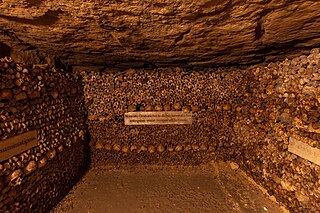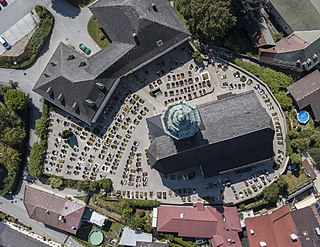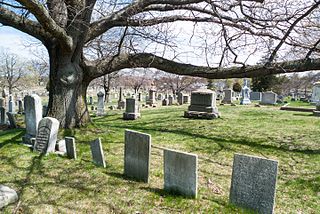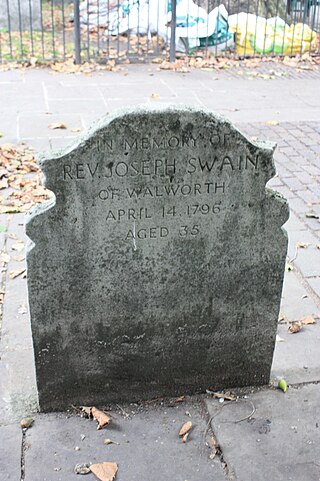
The Catacombs of Paris are underground ossuaries in Paris, France, which hold the remains of more than six million people. Built to consolidate Paris's ancient stone quarries, they extend south from the Barrière d'Enfer former city gate; the ossuary was created as part of the effort to eliminate the effects of the city's overflowing cemeteries. Preparation work began shortly after a 1774 series of basement wall collapses around the Holy Innocents' Cemetery added a sense of urgency to the cemetery-eliminating measure, and from 1788, nightly processions of covered wagons transferred remains from most of Paris's cemeteries to a mine shaft opened near the Rue de la Tombe-Issoire .

Bunhill Fields is a former burial ground in central London, in the London Borough of Islington, just north of the City of London. What remains is about 1.6 hectares in extent and the bulk of the site is a public garden maintained by the City of London Corporation.

An unmarked grave is one that lacks a marker, headstone, or nameplate indicating that a body is buried there. However, in cultures that mark burial sites, the phrase unmarked grave has taken on a metaphorical meaning.

In Christian countries a churchyard is a patch of land adjoining or surrounding a church, which is usually owned by the relevant church or local parish itself. In the Scots language and in both Scottish English and Ulster Scots, this can also be known as a kirkyard.

Ye Antientist Burial Ground is a cemetery in New London, Connecticut, bounded by Hempstead Street on the west and Huntington Street on the east, running from Granite Street to approximately Bristol Street. It has been known by several names over the years, many spelling variations on Ancient Burial Ground. It is one of the earliest graveyards in New England and the oldest colonial cemetery in New London County. The hillside lot of 1.5 acres and adjoins the site of New London's first meeting house. The settlement at the time was called "Pequot Plantation" until the name changed in 1658. From the burial grounds, the visitor has a broad view to the east of the Thames River and, on the far shore, the heights of Groton, Connecticut.

The North Burial Ground is a 110-acre (0.45 km2) cemetery in Providence, Rhode Island dating to 1700, the first public cemetery in Providence. It is located north of downtown Providence, bounded by North Main Street, Branch Avenue, the Moshassuck River, and Cemetery Street. Its main entrance is at the junction of Branch and North Main. The burial ground is one of the larger municipal cemeteries in Southern New England, and it accepts 220 to 225 burials per year.

East Perth Cemeteries was the first cemetery established for the Swan River Colony in 1829 in East Perth, Western Australia. It is estimated that as many as 10,000 people were buried there between 1829 and 1919 in seven independently administered denominations or sections which is why the place is known as 'East Perth Cemeteries'. Only around 800 gravesites have been identified. A large section of the original site has since been built over, leaving about 5 hectares remaining.

The Mechanic Street Cemetery is a historic early cemetery on Mechanic Street in Westfield, Massachusetts. The 4-acre (1.6 ha) cemetery is the city's oldest, with the oldest documented grave dating to 1683. It was used as a burying ground until the late 19th century, although its use began to decline in the middle of the century, with the advent of the popular rural cemetery movement, which was reflected in Westfield with the establishment of the new Pine Hill Cemetery in 1842. No burials were recorded in the 20th century. Although the cemetery has been subjected to some maintenance work, it continues to suffer the effects of vandalism and weather. The cemetery was listed on the National Register of Historic Places in 2002.

Kinne Cemetery, also known as the Glasgo Cemetery and Old Kinne Burying Ground, is a historic cemetery in Jarvis Road in Griswold, Connecticut. The earliest marked stone is for Daniel Kinne who died in 1713. In the 1930s, the inscriptions of 79 stones in the Kinne Cemetery were recorded for the Hale Index. There are around 80 fieldstones with no carving or identification, but it is unknown if this stems from wearing of the gneiss stone or that there were no skilled carvers locally available. The seven carvers that have been identified are Lebbeus Kimball, Jotham Warren, Josiah Manning, Peter Barker, Mr. Huntington of Lebanon, E. Marston of Mystic Bridge and O. Doty of Stonington. The National Historic Register of Places nomination notes, "the cemetery is significant artistically because the carving on the stones gives many good examples of the funerary art that was characteristic of the 18th and 19th centuries in New England." The cemetery is notable because of the burial of Isaac C. Glasko, the namesake of the village of Glasgo, and a prominent African American land-holding man who ran a blacksmith shop that was important to the marine industry of the area. The cemetery was made a part of the Connecticut Freedom Trail in 1995 and it was added to the National Register of Historic Places on April 12, 2001.

Reading Old Cemetery is situated in the eastern part of Reading, Berkshire, England. It is located immediately to the east of Cemetery Junction, a major road junction in Reading. The cemetery is Grade II listed.

The Coddington Cemetery is an early colonial cemetery located in Newport, Rhode Island. It is sometimes called the Friends' Burial Ground, and has more colonial governors buried in it than any other cemetery in the state.

The United Baptist Church, John Clarke Memorial is a historic Baptist church in Newport, Rhode Island, USA that was founded in 1638–1644. It is one of the two oldest Baptist congregations in the United States and is currently affiliated with the American Baptist Churches USA. The current meeting house of the church was constructed in 1846.

Joseph Swain was a British Baptist minister, poet and hymnwriter. Born in Birmingham, and orphaned at an early age, he was apprenticed as an engraver in Birmingham and afterwards in London. He experienced a religious conversion in 1782, and was baptised by John Rippon in the Baptist meeting-house in Carter Lane, Tooley Street, Southwark, on 11 May 1783. He subsequently became a Baptist minister and pastor of East Street Baptist church in Walworth from 1792 until his death in 1796. He was a popular preacher, and during the period of his ministry it became necessary to extend the church building on three occasions.
Columbian Harmony Cemetery was an African-American cemetery that formerly existed at 9th Street NE and Rhode Island Avenue NE in Washington, D.C., in the United States. Constructed in 1859, it was the successor to the smaller Harmoneon Cemetery in downtown Washington. All graves in the cemetery were moved to National Harmony Memorial Park in Landover, Maryland, in 1959. The cemetery site was sold to developers, and a portion used for the Rhode Island Avenue – Brentwood Washington Metro station.

The Congregationalist Cemetery at Ponsharden, Cornwall was opened in 1808 to serve the Dissenting Christian congregations of Falmouth and Penryn. It received approximately 587 burials over a period of 120 years, before being abandoned in the 1930s. During the 20th century the site experienced significant neglect and extensive vandalism. In May 2012 a volunteer group began to restore the burial ground which is now a protected Scheduled Monument of national importance. The place-name Ponsharden is recorded in 1677 as "Ponshardy"; its meaning is Hardy's bridge.

Funerary art in Puritan New England encompasses graveyard headstones carved between c. 1640 and the late 18th century by the Puritans, founders of the first American colonies, and their descendants. Early New England Puritan funerary art conveys a practical attitude towards 17th-century mortality; death was an ever-present reality of life, and their funerary traditions and grave art provide a unique insight into their views on death. The minimalist decoration and lack of embellishment of the early headstone designs reflect the British Puritan and Anglo-Saxon religious cultures.

South Rockhampton Cemetery is a heritage-listed cemetery at Upper Dawson Road, Allenstown, Rockhampton Region, Queensland, Australia. It was built from 1860 to 1970. It is also known as Dawson Road Cemetery and Rockhampton Cemetery. It was added to the Queensland Heritage Register on 15 February 1993.

Greyfriars Burial Ground is an historic cemetery in Perth, Scotland. Dating to 1580, it is now Category A listed, with its collection of gravestones considered one of the best in Scotland. The cemetery closed to burials in 1978.



















